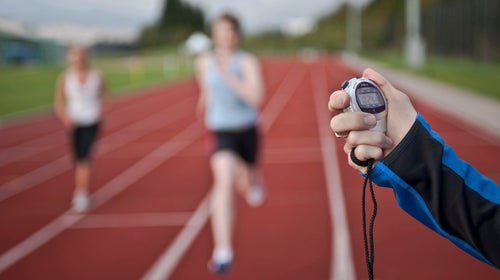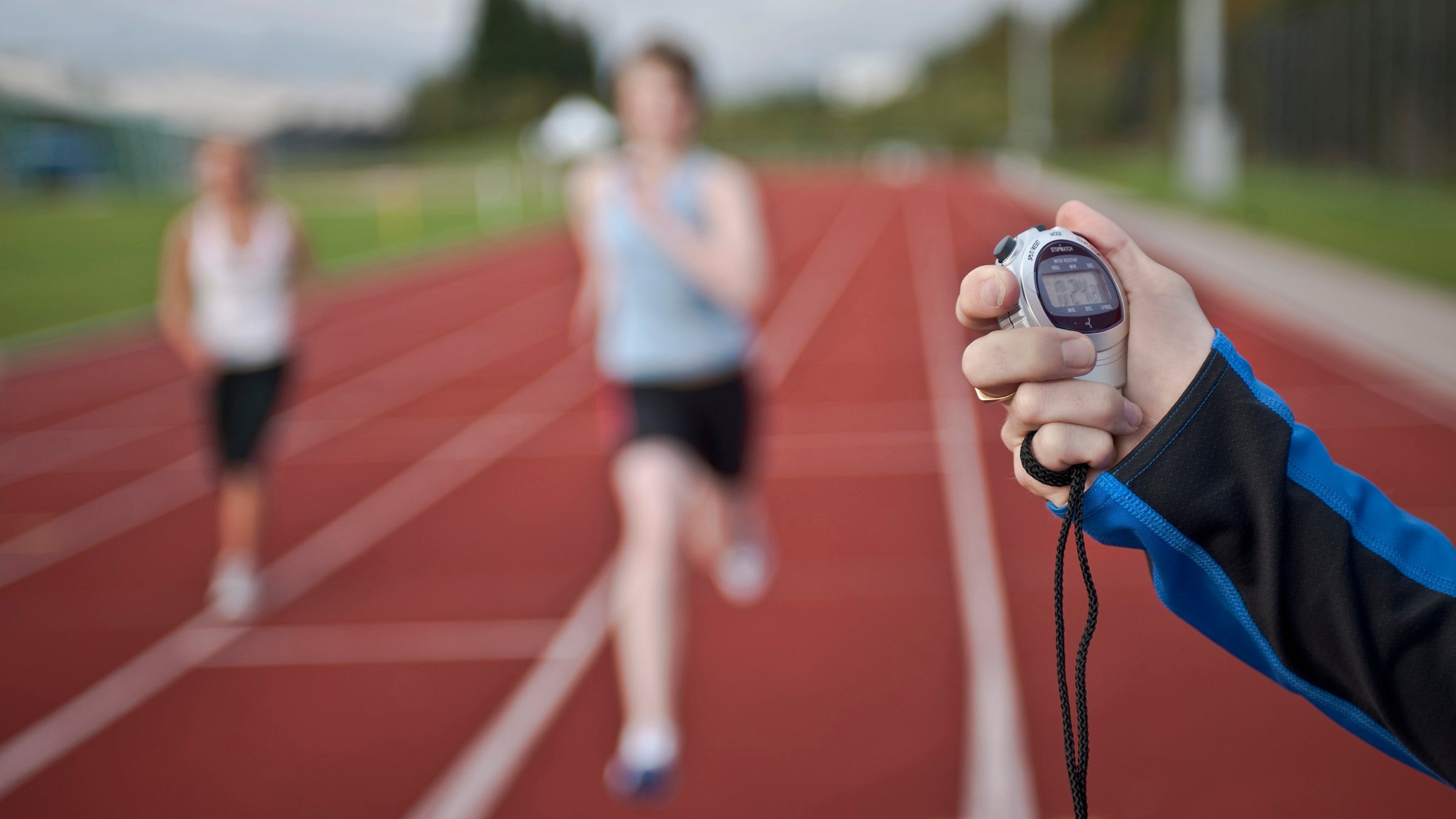Some decades ago, British coach Frank Horwill, founder of the British Milers Club, developed what he called the 4-second rule for establishing training paces.
For Horwill, it was mostly an adjunct to his five-pace training system, used by such 1970s and ’80s luminaries as Sebastian Coe (two-time Olympic gold medal winner at 1500m), Tim Hutchings (4th in the 5000m at the 1984 Olympics), and Said Aouita (world-record holder at four distances, and 1984 Olympic 5000m winner).
But the rule isn’t just a way to establish training paces under Horwill’s system (in which you train at race pace, plus two “paces,” faster and slower, to each side of it). It’s also a pretty good rule of thumb for road runners trying to extrapolate a 5K goal from a mile, or a marathon goal from a half-marathon or even a 10K.
Horwill’s brainstorm was to note that paces at the standard race distances: 1500m, 3000m, 5K, 10K, half-marathon, and marathon follow a fairly linear progression, with each step up the ladder entailing about the same amount of slow-down as the one before it.
For example, he wrote in an undated article now reprinted by the London-based Serpentine running club, consider “John,” a 4-minute 1500m runner.
“[That] is 64 seconds per lap,” he wrote. “If we now add 4 secs to this (68 secs), that is his forecast for running 3K. If we add a further 4 secs to the 3km prediction (72 secs), that is his forecast for 5km. The forecast for 10km would be 76 secs/400m.”
Bottom line: John’s 1500m time is comparable to 8:30 for 3K, 15:00 for 5K, and 31:40 for 10K.
In that article, Horwill didn’t carry that assessment all the way up to the marathon, but if he had, “John” would run 84 sec/400 for the marathon, or 5:38 per mile (taking into account the difference between four 400m laps and the mile). That’s within 10 seconds per mile of what you get from today’s best online race-prediction calculators. And it’s extrapolating all the way from the 1500 to the marathon. Not bad for a simple, easy-to-remember rule of thumb.

Scaled for Speed
For women, Horwill used a 5-second rule, scaling it to their slightly slower race paces. “For instance,” he wrote, “Mary is a 4:30/1,500m runner, which is 72 secs/400m.” He then predicted her times from 3K to 10K as 5 seconds slower per 400m for every step up: 77 secs/400m (9:37.5) for 3K, 82 secs/400m (17:05) for 5K, and 87 secs/400m (36:15) for 10K.
It should be noted, though, that John and Mary are elite, but not world-class. If you look at world records, the “steps” between race paces at the standard distances appear to be more like 3 sec/lap for men, and perhaps 3.5 sec per lap for women. I.e., Horwill’s rule of thumb varies with speed. The faster you are, the smaller the “steps.”
One of Horwill’s greatest advocates is Peter Thompson, another British coach with international experience, now a long-time resident of Eugene, Oregon. In a 2016 analysis, he used 800m paces to set the differential between steps rather than 1500m, which simplifies the test for most runners (when was the last time you ran 1500m fast?).
If you run the 800 in 2 minutes, he suggested, that makes your per-mile pace for that event 4 minutes. That’s the pace you were going in those two minutes. If that’s you, he says, that means the 4-second rule should apply.
If you run the 800 in 2:30, that’s a 5-minute mile pace, and you should use a 5-second rule per 400m (or 20 seconds per mile) in estimating how much you’ll slow down during each step up in race distance from mile to marathon.
By the same calculus, if you run the 800 in 3 minutes, you should use a 6-second rule per 400m or 24 seconds/mile.
For example:
| 800m Time | Mile pace | 3,000m pace | 5,000m pace | 10,000m pace | Half Marathon pace | Marathon pace |
|---|---|---|---|---|---|---|
| 3:00 | 6:24 pace | 6:48 pace | 7:12 pace | 7:36 pace | 8:00 pace | 8:24 pace |
The pattern holds all the way up to at least 4 minutes for the 800m. If you don’t fall neatly on the minute or half minute, you can round your rule to the nearest second, e.g., a runner who hits 800m in 2:50 can use the above estimated paces.
Training Paces and Priorities
Once you’ve figured what version of Horwill’s rule (4 seconds, 5 seconds, 6 seconds, or more) applies to your pace, it’s simple, elegant, and super-easy to apply during training.
That’s important, because the reality is that speed work isn’t rocket science. It’s not like you are NASA, hoping to nail a Mars landing but knowing that if you make a one part in a million error, you’ll instead produce a multi-billion-dollar crash.
If you are a 5K runner trying to do a workout at 1500m pace, or a 10K runner trying to do one at marathon pace, missing by a few seconds a mile isn’t the end of the world. Wind, weather, job stress, what you ate for breakfast — all of these can have bigger effects. The simplicity of Horwill’s rule (adapted for your own pace) is that it gives you a ballpark to shoot for. If you’re off by a little, no big deal.
If you’re off by a lot, however, that’s useful information. “The four seconds rule [or whatever version of it applies to you] helps identify limiting factors,” Thompson says.
If your pace falls off at shorter distances, he says, you lack speed and need to train at paces well faster than your target race pace. I’ve applied this to elite marathoners, for example, having them do 10 x 400 at Horwill’s projected 1500m pace, based on their marathon times. If they couldn’t hit that the first time, we worked on it for a few weeks.
If your pace falls off at longer distances, then speed isn’t your problem. Instead, Thompson says, you lack endurance. The primary effort in your training should be on improving that, perhaps in the form of long runs, tempo, or increased volume (if you can do it without injury).

Signaling Your Strengths
Checking how you line up against Horwill’s rule (again adjusted for your speed) is also useful guidance if you are thinking about changing race distances.
A case in point is Lauren Elgee, now a graduate student at the University of Massachusetts, Amherst. A few years ago, she saw herself as a 5K/cross-country runner. At which she was good, captaining a top-20 team at USATF club nationals. But in training, she was also really fast at shorter distances, such as 200m repeats. So she downshifted, first to the 1500m, and then all the way to the 800m. Not because Horwill’s rule said she had a weakness, but because it suggested a strength she’d never chosen to explore. “In college, I only ran cross-country,” she says.
Within a year, she was scoring national-class times at both distances, including an 800m result (2:14.25) vastly faster than anything predicted by her best times at longer distances.
Not that she knew Horwill’s rule of thumb when she made the shift. Rather, she says, “I always had this feeling that I was more suited for shorter distances, because they were the sorts of workouts where my legs just felt right, and I could just fly.” Horwill’s rule simply confirmed that this feeling was correct.
But now, like Thompson’s runner whose pace falls off at longer distances, she wonders if she can take that 800m/1500m speed and ratchet it back up to longer distances.
“It made me curious about the 5K,” she says, “wondering if now that I’ve tapped into that speed, there isn’t another gear for the 5K.”
The bottom line, Thompson says, is that even though it’s now 50 years old, Horwill’s rule, modified as needed for your own speed, has lost none of its simple elegance. “It still remains relevant,” he says.


